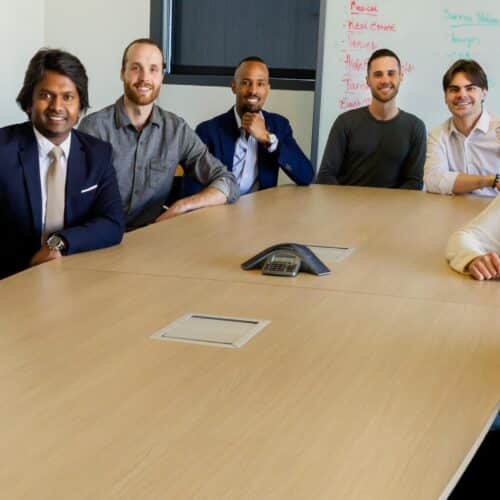In our nonprofit world, one topic causes more anxiety, angst, and teeth-gnashing than all others combined.
You know I’m talking about boards. And you’re tensing up right now, just thinking about the topic, right? Odds are, you’ve had your share of board-related headaches (alongside – I hope – some productive, effective, and satisfying relationships with your organization’s board members).
The uneasy relationship between professional fundraisers and nonprofit boards isn’t a new problem. How many of us have been greeted with groans, nervous glances, and disappearing board members at the mere mention of active engagement with fundraising? (All hands in air.)
Here’s the rub: While board members understand that fundraising is a key piece of an organization’s fiscal health… When it comes to actually doing the fundraising as active participants, things fall apart.
There are a few reasons board members don’t like to fundraise or don’t feel confident fundraising, which I’ve written about before. Fundamentals, tools, and training are all crucial.
But it’s also time to start seriously examining WHO’S on our nonprofit boards. It’s an integral component for healthy board governance and a successful, sustainable fundraising partnership.
Now’s the time to move past old beliefs and myths. Example: that the ideal board is composed of celebrities and megadonors. (It’s an easy trap: After all, if people with wealth and wealthy friends are involved, wouldn’t that solve all our organizational financial woes?)
Your board isn’t just a list of names. You need volunteer leaders who are committed to your mission and ready to actually do some work. It doesn’t mean mega donors and celebrities wouldn’t or can’t. But their schedules and other commitments may prevent them from being fully present to take on the responsibilities you really need from your board members.
So who and what DO you need on your nonprofit board?
1. Talent & Skills
Look at your strategic plan and reflect on your upcoming needs. Start by using a gap assessment to quantify the skills and representations you have now, what’s missing, and what you need to be successful in years ahead. Look at skills like legal, financial, marketing, fundraising (there it is again), and programmatic expertise that is essential for your organization’s success.
2. Reputation
A recent article in the New York Times depicted boycotts and protests at several major arts institutions here and abroad. Protesters called for the resignation of board members who own companies that have made questionable business practices and families who have skirted close to the edge of controversy. Here is a perfect example of the visible role boards play in your nonprofit’s credibility – and fundraising potential. As your nonprofit assesses and recruits your board, do you look for potential reputational risks to the organization?
3. Representation
Most importantly, evaluate whether your board is representative of the communities you serve and the funders who support you.
Gender, equity, diversity, and inclusion is still an issue that needs to be more effectively incorporated into the nonprofit sector – so much so that it warranted its own chapter in the recent Rogare Critical Fundraising Report (USA) that I chaired. The simple fact is that nonprofit boards, staff, and donors are still not reflective of the American population or our communities. Anne Wallestad, president of Board Source, says, “Boards should be a place where diversity thrives. Their structure enables them to tap into a wide range of experience, expertise, and networks. When organizations populate themselves in a way that is homogeneous, they are narrowing their boards’ worldview in a way that can be deeply problematic.”
Improving diversity on boards remains a sector-wide issue, and one that just isn’t a priority for some reason. According to BoardSource’s 2017 Leading With Intent, “Ninety-six percent of nonprofit leaders say that diversifying their board of directors is important, but only 24 percent of boards have taken steps to do so.”
Consider this:
Blackbaud Institute’s Diversity in Giving report in 2015 found that African Americans and Hispanics, in particular, are underrepresented among donors. They reported less frequent solicitations than other groups but also reported a likelihood to give more if asked more often. Other studies show that these same groups give more than white donors as a percentage of income. We know from the research that people of color and women tend to be more generous than white, male donors. So, why, for example, are our nonprofit boards still 85% white?
Lack of diversity on our boards means not having a true range of representation, experiences, and perspectives on our boards and among our leadership. And it might also be a missed opportunity to grow revenue from those very donors we are overlooking or not attracting (because of the composition of our boards and staff…You get the picture).
If you’re still not convinced that examining your current and future board through these lenses is worth the time, here’s another angle: Who’s on our boards really can influence our ability and inability to raise funds.Charitable giving in the US has been stuck at 2% of the GDP for at least 10 years (at least). We know changes are required to move the dial. As my colleague, Ashley Belanger asserts in her chapter of the Rogare report, maybe if we start recruiting, cultivating, and nurturing boards that meet our REAL needs, we can create the change we want to see. We can diversify our donor base and reap the rewards of leadership teams who are working with us in the trenches, skilled and deeply, dedicated to the work of growing and sustaining our mission, and truly representative.
Name-on-a-list, minimally engaged, homogeneous boards are no longer enough. What can YOU do this year to help build a board truly fitted to fulfilling your mission, fundraising and all?
For more on how to empower your Board for fundraising success, check out the revised e-guide I wrote for Network for Good and join me on 6/25 for my UST webinar, “3 Reasons Your Board Doesn’t Fundraise.”.





